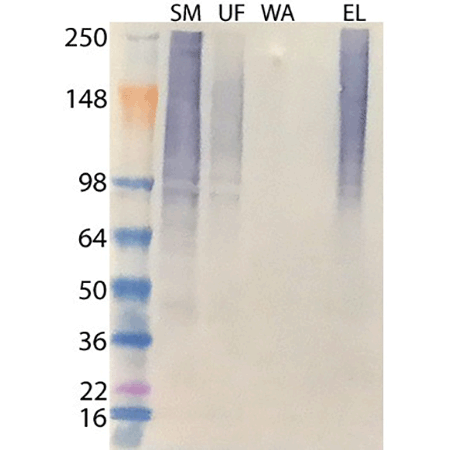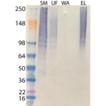Replaces Prod. #: BML-UW8995
-
Efficient tool for the selective isolation of ubiquitinylated proteins
-
High binding affinity matrix, able to bind both monoubiquitinated and polyubiquitinated proteins
-
Highly compatible with a wide range of lysate buffer, different sample types (cells, tissues) and a broad range of species
For isolation and enrichment of ubiquitinylated proteins.The UBI-QAPTURE-Q® kit is an efficient tool for the selective isolation of ubiquitinylated proteins. The Kit facilitates the isolation of both mono- and poly-ubiquitinylated proteins (independent of lysine residue chain linkage) from cell extracts, tissue lysates and in vitro assay solutions through use of a high-binding affinity matrix. Captured proteins can be analyzed by Western blotting using the highly sensitive ubiquitin-conjugate specific antibody provided, using antibodies to specific proteins of interest, or eluted from the matrix for subsequent biochemical characterization. The UBI-QAPTURE-Q® matrix supplied with the kit has superior binding characteristics compared to other commercially available matrices and is compatible with a wide range of lysate buffers and cell/tissue samples from a variety of species.

Western Blot analysis of ubiquitin enrichment of lysate derived ubiquitinylated proteins. Ubiquitin enrichment experiment set-up and run as described in UBIQAPTURE-Q® kit (Prod. No. BML-UW8995A). Ubiquitin-protein conjugates present in starting material, unbound fraction and elution fraction were detected by western blotting using the provided ubiquitin-conjugate specific HRP-linked antibody (Prod. No. ENZ-ABS840HRP) at a dilution of 1:1000. Key: SM = Starting Material, UF = Unbound Fraction, WA = Wash Fraction, and EL = Elution Fraction.
Please mouse over
Product Details
| Application Notes: | Uses:
-
Isolation and detection of the full range of ubiquitinylated protein conjugates (mono-/multi-/poly-ubiquitin modified, lysine linkage independent) from specific cell/tissue lysates of interest, especially low abundance (regulatory) proteins involved in the ubiquitin-proteasome pathway.
-
Capture and analysis of specific ubiquitinylated protein conjugates of interest from particular cell/tissue lysates.
-
Purification/pull down of ubiquitinylated proteins from cell free in vitro assays; for example to isolate Ub-p53 species from ubiquitinylation assays mediated by HeLa S100 lysate (Prod. No. BML-SW8750).
-
Release of free proteins in their active/native form by cleavage of ubiquitin/ubiquitin chains from the UBI-QAPTURE-Q® matrix using deubiquitinylating enzymes such as USP2 (Prod. No. BML-UW9850).
-
Release of ubiquitinylated proteins in their active/native form by elution from the UBI-QAPTURE-Q® matrix using, for example, high salt buffer.
Note: Protocol provided covers applications 1-3. Assay set-up can be readily modified for alternative applications by inclusion, omission or substitution of specific components. Kit is not suitable for use with purified proteins. |
| |
| Quantity: | Provides sufficient material for 20 x 20μl reactions. |
| |
| Use/Stability: | Upon receipt, the control lysate (Prod. No. BML-UW0130) should be stored at -80°C. All other components should be stored at 4°C. |
| |
| Shipping: | Dry Ice |
| |
| Long Term Storage: | -80°C |
| |
| Contents: | UBI-QAPTURE-Q® matrix (Prod. No. BML-UW0125) 0.5 ml settled resin provided; 50% suspension.
Control ubiquitinylated-protein lysate (Ub-lysate) (Prod. No. BML-UW0130) 500 µg (100µl), 5mg/ml in 50mM HEPES, pH 7.6, 1mM DTT.
Mono- and polyubiquitinylated conjugates monoclonal antibody (UBCJ2) (HRP conjugate) (Ubiquitin-conjugates specific HRP-linked antibody solution) (Prod. No. ENZ-ABS840HRP) 25µl. |
| |
| Regulatory Status: | RUO - Research Use Only |
| |
Product Literature References
Susceptibility of Toxoplasma gondii to autophagy in human cells relies on multiple interacting parasite loci: N. Rinkenberger, et al.; Mbio e0259523 (2023),
Abstract;
Cotranslational N-degron masking by acetylation promotes proteome stability in plants: E. Linster, et al.; Nat. Commun.
13, 810 (2022),
Abstract;
SPRTN and TDP1/TDP2 Independently Suppress 5-Aza-2′-deoxycytidine-Induced Genomic Instability in Human TK6 Cell Line: T. Nakano, et al.; Chem. Res. Toxicol.
35, 2059 (2022),
Abstract;
Parkin-independent mitophagy via Drp1-mediated outer membrane severing and inner membrane ubiquitination: Y. Oshima, et al.; J. Cell Biol.
220, 202006043 (2021),
Abstract;
Benzo[a]pyrene represses DNA repair through altered E2F1/E2F4 function marking an early event in DNA damage-induced cellular senescence: S. Allmann, et al.; Nucleic Acids Res.
48, 12085 (2020),
Abstract;
Full Text
Human Cytomegalovirus Tegument Protein pp65 (pUL83) Dampens Type I Interferon Production by Inactivating the DNA Sensor cGAS without Affecting STING: M. Biolatti, et al.; J. Virol.
92, e01774 (2018),
Abstract;
Full Text
TRIM24 mediates the interaction of the retinoic acid receptor alpha with the proteasome: M. Carrier, et al.; FEBS Lett.
592, 1426 (2018),
Abstract;
Full Text
Ubiquitination of the Cytoplasmic Domain of Influenza A Virus M2 Protein Is Crucial for Production of Infectious Virus Particles: W.C. Su, et al.; J. Virol.
92, e01972 (2018),
Abstract;
Full Text
Aging Triggers Cytoplasmic Depletion and Nuclear Translocation of the E3 Ligase Mahogunin: A Function for Ubiquitin in Neuronal Survival: S. Benvegnu, et al.; Mol. Cell
66, 358 (2017),
Abstract;
Antiglioma effects of N6-isopentenyladenosine, an endogenous isoprenoid end product, through the downregulation of epidermal growth factor receptor: E. Ciaglia, et al.; Int. J. Cancer
140, 959 (2017),
Abstract;
Full Text
Manganese-Mediated Decrease in Levels of c-RET and Tyrosine Hydroxylase Expression In Vitro: M.Y. Kumasaka, et al.; Neurotox. Res.
32, 661 (2017),
Abstract;
miR-100 antagonism triggers apoptosis by inhibiting ubiquitination-mediated p53 degradation: G. Yang, et al.; Oncogene
36, 1023 (2017),
Application(s): Detection of ubiquitinated protein,
Abstract;
Mycobacterium tuberculosis Controls Phagosomal Acidification by Targeting CISH-Mediated Signaling: C.J. Queval, et al.; Cell Rep.
20, 3188 (2017),
Abstract;
Full Text
The CreB deubiquitinating enzyme does not directly target the CreA repressor protein in Aspergillus nidulans: M.A. Alam, et al.; Curr. Genet.
63, 647 (2017),
Abstract;
The Pepper RING-Type E3 Ligase CaAIRF1 Regulates ABA and Drought Signaling via CaADIP1 Protein Phosphatase Degradation: C.W. Lim, et al.; Plant Physiol.
173, 2323 (2017),
Abstract;
Full Text
The ubiquitin-conjugating enzyme CDC34 is essential for cytokinesis in contrast to putative subunits of a SCF complex in Trypanosoma brucei: F. Rojas, et al.; PLoS Negl. Trop. Dis.
11, e0005626 (2017),
Abstract;
Full Text
E11/podoplanin protein stabilization through inhibition of the proteasome promotes osteocyte differentiation in murine in vitro models: K.A. Staines, et al.; J. Cell. Physiol.
231, 1392 (2016),
Abstract;
Full Text
The ubiquitination of serotonin transporter in lymphoblasts derived from fluvoxamine-resistant depression patients: A. Mouri, et al.; Neurosci. Lett.
617, 22 (2016),
Application(s): Detection of ubiquitinylated protein,
Abstract;
PI3K/AKT signaling inhibits NOTCH1 lysosome‐mediated degradation: N. Platonova, et al.; Genes Chromosomes Cancer
54, 516 (2015),
Abstract;
SKP2 cooperates with N-Ras or AKT to induce liver tumor development in mice: S. Delogu, et al.; Oncotarget
6, 2222 (2015),
Abstract;
Full Text
TRPM8 channel as a novel molecular target in androgen-regulated prostate cancer cells: S. Asuthkar, et al.; Oncotarget
6, 17221 (2015),
Abstract;
Full Text
A Heart That Beats for 500 Years: Age-Related Changes in Cardiac Proteasome Activity, Oxidative Protein Damage and Expression of Heat Shock Proteins, Inflammatory Factors, and Mitochondrial Complexes in Arctica islandica, the Longest-Living Noncolonial Animal: D. Sosnowska, et al.; J Gerontol A Biol Sci Med Sci
69, 1448 (2014),
Abstract;
Full Text
Chloroquine reduces osteoclastogenesis in murine osteoporosis by preventing TRAF3 degradation: Y. Xiu, et al.; J. Clin. Invest.
124, 297 (2014),
Abstract;
Full Text
HIV-1 Nef down-modulates C-C and C-X-C chemokine receptors via ubiquitin and ubiquitin-independent mechanism: P. Chandrasekaran, et al.; PLoS One
9, e86998 (2014),
Abstract;
Full Text
Nuclear translocation of Hand-1 acts as a molecular switch to regulate vascular radiosensitivity in medulloblastoma tumors: the protein uPAR is a cytoplasmic sequestration factor for Hand-1: S. Asuthkar, et al.; Mol. Cancer Ther.
13, 1309 (2014),
Abstract;
Full Text
Activin receptor-like kinase5 inhibition suppresses mouse melanoma by ubiquitin degradation of Smad4, thereby derepressing eomesodermin in cytotoxic T lymphocytes: J.H. Yoon, et al.; EMBO Mol. Med.
5, 1720 (2013),
Abstract;
An immunoaffinity purification method for the proteomic analysis of ubiquitinated protein complexes: P. Schwertman, et al.; Anal. Biochem.
440, 227 (2013),
Abstract;
Deletion of the Type II TGF-β receptor gene in articular chondrocytes leads to a progressive OA-like phenotype in mice: J. Shen, et al.; Arthritis Rheum.
65, 3107 (2013),
Abstract;
Full Text
The Giardia cell cycle progresses independently of the anaphase-promoting complex: S. Gourguechon, et al.; J. Cell Sci.
126, 2246 (2013),
Abstract;
Full Text
Ubiquitin E3 Ligase Itch Negatively Regulates Osteoclast Formation by Promoting Deubiquitination of Tumor Necrosis Factor (TNF) Receptor-associated Factor 6: H. Zhang, et al.; J. Biol. Chem.
288, 22359 (2013),
Abstract;
Full Text
Chaperones, but not oxidized proteins, are ubiquitinated after oxidative stress: M. Kästle, et al.; Free Radic. Biol. Med.
53, 1468 (2012),
Abstract;
MAGE-D1 regulates expression of depression-like behavior through serotonin transport ubiquitylation: A. Mouri, et al.; J. Neurosci
32, 4562 (2012),
Abstract;
Full Text
Proteomic analysis of ubiquitination-associated proteins in a cisplatin-resistant human lung adenocarcinoma cell line: X. Qin, et al.; Int. J. Mol. Med.
29, 791 (2012),
Abstract;
Ubiquitin-mediated control of plant hormone signaling: D.R. Kelley & M. Estelle; Plant Physiol.
160, 47 (2012),
Abstract;
A tetrapyrrole-regulated ubiquitin ligase controls algal nuclear DNA replication: Y. Kobayashi, et al.; Nat. Cell. Biol.
13, 483 (2011),
Abstract;
BMP2, but not BMP4, is crucial for chondrocyte proliferation and maturation during endochondral bone development: B. Shu, et al.; J. Cell Sci.
124, 3428 (2011),
Abstract;
Neuronal precursor cell-expressed developmentally down-regulated 4-1 (NEDD4-1) controls the sorting of newly synthesized Cav1.2 calcium channels: J. Rougier, et al.; J. Biol. Chem.
286, 8829 (2011),
Abstract;
Full Text
Proteins bearing oxidation-induced carbonyl groups are not preferentially ubiquitinated: M. Kästle & T. Grune; Biochimie
93, 1076 (2011),
Abstract;
The role of the ubiquitin proteasome system in Alzheimer's disease: B.M. Riederer, et al.; Exp. Biol. Med.
236, 268 (2011),
Abstract;
Cross-talk between remodeling and de novo pathways maintains phospholipid balance through ubiquitination: P.L. Butler & R.K. Mallampalli; J. Biol. Chem.
285, 6246 (2010),
Abstract;
Full Text
Smad3 prevents beta-catenin degradation and facilitates beta-catenin nuclear translocation in chondrocytes: M. Zhang, et al.; J. Biol. Chem.
285, 8703 (2010),
Abstract;
Full Text
BAX/BAK-independent mitoptosis during cell death induced by proteasome inhibition: E. Lomonosova, et al.; Mol. Cancer Res.
7, 1268 (2009),
Abstract;
Full Text
Homologous recombination but not nucleotide excision repair plays a pivotal role in tolerance of DNA-protein cross-links in mammalian cells: T. Nakano, et al.; J. Biol. Chem.
284, 27065 (2009),
Abstract;
Full Text
Related Products













